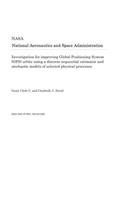
Investigation for Improving Global Positioning System (Gps) Orbits Using a Discrete Sequential Estimator and Stochastic Models of Selected Physical Processes
Series:
GEODYNII is a conventional batch least-squares differential corrector computer program with deterministic models of the physical environment. Conventional algorithms were used to process differenced phase and pseudorange data to determine eight-day Global Positioning system (GPS) orbits with several meter accuracy. However, random physical processes drive the errors whose magnitudes prevent improv
NaN
VOLUME
English
Paperback

GEODYNII is a conventional batch least-squares differential corrector computer program with deterministic models of the physical environment. Conventional algorithms were used to process differenced phase and pseudorange data to determine eight-day Global Positioning system (GPS) orbits with several meter accuracy. However, random physical processes drive the errors whose magnitudes prevent improving the GPS orbit accuracy. To improve the orbit accuracy, these random processes should be modeled stochastically. The conventional batch least-squares algorithm cannot accommodate stochastic models, only a stochastic estimation algorithm is suitable, such as a sequential filter/smoother. Also, GEODYNII cannot currently model the correlation among data values. Differenced pseudorange, and especially differenced phase, are precise data types that can be used to improve the GPS orbit precision. To overcome these limitations and improve the accuracy of GPS orbits computed using GEODYNII, we proposed to develop a sequential stochastic filter/smoother processor by using GEODYNII as a type of trajectory preprocessor. Our proposed processor is now completed. It contains a correlated double difference range processing capability, first order Gauss Markov models for the solar radiation pressure scale coefficient and y-bias acceleration, and a random walk model for the tropospheric refraction correction. The development approach was to interface the standard GEODYNII output files (measurement partials and variationals) with software modules containing the stochastic estimator, the stochastic models, and a double differenced phase range processing routine. Thus, no modifications to the original GEODYNII software were required. A schematic of the development is shown. The observational data are edited in the preprocessor and the data are passed to GEODYNII as one of its standard data types. A reference orbit is determined using GEODYNII as a batch least-squares processor and the GEODY...
Price Comparison [India]
In This Series
Bestseller Manga
Trending NEWS




















